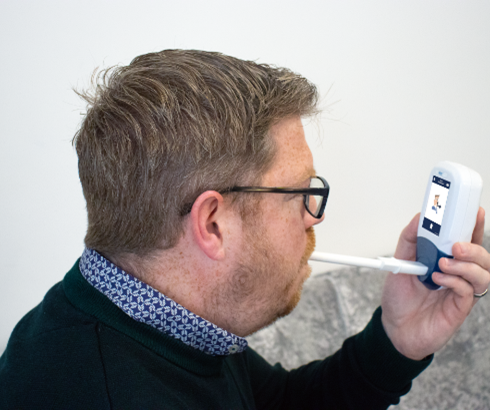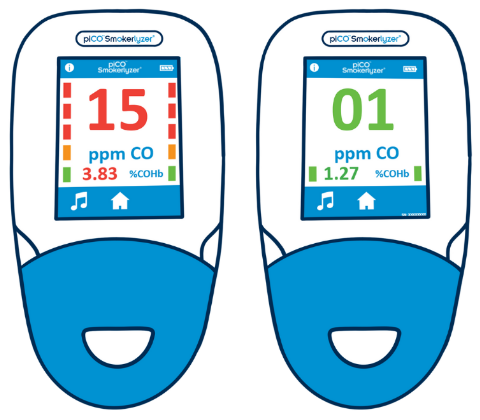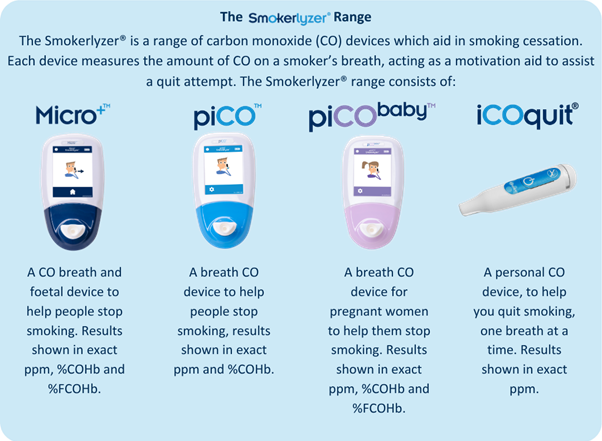Stoptober is a national smoking cessation campaign designed to help people quit smoking. Established in 2012 by Public Health England (PHE), Stoptober challenges smokers to kick the habit for 28 days.
Quitting is notoriously difficult, but studies show that if you can go without a cigarette for 28 days, you're five times more likely to stop altogether.1
Since giving up smoking is such a big challenge, it’s important to know which tools are available to help. In this article, Bedfont Scientific explains why carbon monoxide (CO) monitoring is a valuable tool for smokers who want to quit.
What is CO?

Image Credit: ARVD73/Shutterstock.com
CO is an odorless, colorless gas formed by incomplete combustion, including from the burning of tobacco. It’s dangerous to inhale because it enters your bloodstream through your lungs, then attaches to the hemoglobin in your red blood cells, which stops them from carrying oxygen. This deprives your body of the oxygen it needs to function properly, leading to smoking-related health problems.2
That said, once you make the decision to quit smoking, the benefits start to appear fairly quickly. In fact, within just 48 hours of your last cigarette, your carbon monoxide levels return to those of a non-smoker.3
How do CO monitoring devices work?

Image Credit: Bedfont® Scientific Ltd
CO monitoring offers instant feedback for users who want to know their smoking-related CO levels. It’s a quick, simple, non-invasive way to establish smoking status by determining the CO levels in exhaled breath, measured in ppm (parts per million). Devices like the Smokerlyzer® range are portable and compact, so they’re easy to use at home, as well as in clinics.
How do CO monitoring devices help you quit smoking?

Image Credit: Bedfont® Scientific Ltd
When you're trying to quit smoking, seeing your CO levels drop over time can be a powerful motivator. It provides a clear, visual reminder of your progress and reinforces your reasons for quitting.
For instance, a 2012 study that explored the effectiveness of personal CO monitoring on smoking cessation found that out of 10 smokers, “7 of the smokers reported that they felt as though the devices had reduced their cigarette consumption… 6 smokers reported a lower nicotine dependency relative to baseline. Over the 6 weeks, there appeared to be a significant decline in the number of cigarettes smoked per day.”4
About the Smokerlyzer® range
The Smokerlyzer® range is a series of CO monitoring devices built to help smokers quit. It includes:
- Micro+™ Smokerlyzer® - A CO breath and fetal device that aids smoking cessation. Results are displayed in exact ppm, carboxyhaemoglobin (%COHb), and fetal carboxyhaemoglobin (%FCOHb).
- PiCO™ Smokerlyzer® - A breath CO device that helps people quit smoking. Results are shown in exact ppm and %COHb.
- PiCObaby™ Smokerlyzer® - A breath CO device for pregnant women to help them quit smoking. Results are shown in exact ppm, %COHb, and %FCOHb.
- iCOquit® Smokerlyzer® - A personal CO device to help individuals stop smoking, one breath at a time. Results are shown in exact ppm.

Image Credit: Bedfont® Scientific Ltd
Incorporating CO monitoring into your Stoptober plan
When you decide to give up smoking, it is advised that you speak to a healthcare professional about the tools available to help you quit. CO monitoring devices are available in smoking cessation clinics around the world, and smoking cessation advisors can build a structured plan to help you quit for good.
Stopober is just the beginning
Stoptober is the perfect excuse to quit smoking, but your journey shouldn’t end when November starts. CO monitoring helps you visualize your progress throughout your attempt to quit, making it easier to continue your journey toward a smoke-free life.
Overall, the best way to quit smoking involves a combination of commitment, support, and CO monitoring.
References and further reading
- Nclhealthandcare.org.uk. (2025). Stop Smoking this Stoptober and You will be Five Times More Likely to Quit for Good! | North Central London Integrated Care System. (online) Available at: https://nclhealthandcare.org.uk/news/stop-smoking-this-stoptober-and-you-will-be-five-times-more-likely-to-quit-for-good/.
- Department of Health and Aged Care (2024). Effects of Smoking and Tobacco. (online) Australian Government Department of Health and Aged Care. Available at: https://www.health.gov.au/topics/smoking-vaping-and-tobacco/about-smoking/effects.
- NHS (2020). Quit smoking - better health. (online) NHS.UK. Available at: https://www.nhs.uk/better-health/quit-smoking/.
- Beard, E. and West, R. (2012). Pilot Study of the Use of Personal Carbon Monoxide Monitoring to Achieve Radical Smoking Reduction. Journal of Smoking Cessation, 7(1), pp.12–17. https://doi.org/10.1017/jsc.2012.1.
About Bedfont® Scientific Ltd
Bedfont® Scientific has specialised in the design and manufacture of exhaled breath and gas monitoring instruments since 1976.
For medical gas monitoring, their Medi-Gas Check medical pipeline testing range verifies not only the quantity but also quality of gas administered to patients.
Bedfont's breath analysers include carbon monoxide (CO) monitors such as the Smokerlyzer®, used for smoking cessation, and the ToxCO®, used by emergency services, to diagnose CO poisoning.
The NObreath® FeNO monitor provides accurate analysis of airway inflammation for the control of asthma, and the Gastrolyzer® range aids in the detection of gastrointestinal disorders and food intolerances. Quick and non-invasive, breath analysis is the new blood test.
Sponsored Content Policy: News-Medical.net publishes articles and related content that may be derived from sources where we have existing commercial relationships, provided such content adds value to the core editorial ethos of News-Medical.Net which is to educate and inform site visitors interested in medical research, science, medical devices and treatments.